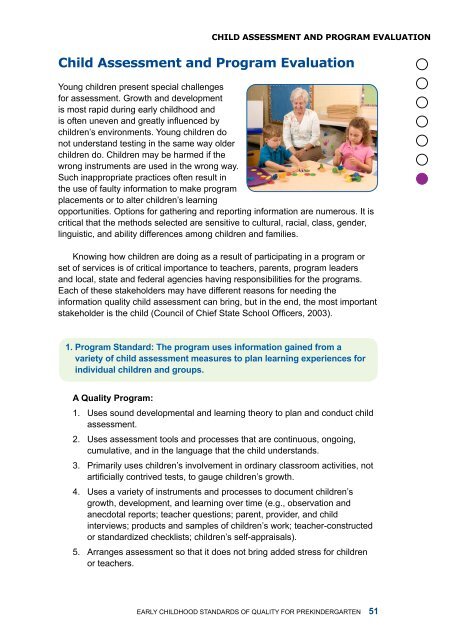Early Childhood Standards of Quality for ... - State of Michigan
Early Childhood Standards of Quality for ... - State of Michigan
Early Childhood Standards of Quality for ... - State of Michigan
You also want an ePaper? Increase the reach of your titles
YUMPU automatically turns print PDFs into web optimized ePapers that Google loves.
Child Assessment and Program EvaluationChild Assessment and Program EvaluationYoung children present special challenges<strong>for</strong> assessment. Growth and developmentis most rapid during early childhood andis <strong>of</strong>ten uneven and greatly influenced bychildren’s environments. Young children donot understand testing in the same way olderchildren do. Children may be harmed if thewrong instruments are used in the wrong way.Such inappropriate practices <strong>of</strong>ten result inthe use <strong>of</strong> faulty in<strong>for</strong>mation to make programplacements or to alter children’s learningopportunities. Options <strong>for</strong> gathering and reporting in<strong>for</strong>mation are numerous. It iscritical that the methods selected are sensitive to cultural, racial, class, gender,linguistic, and ability differences among children and families.Knowing how children are doing as a result <strong>of</strong> participating in a program orset <strong>of</strong> services is <strong>of</strong> critical importance to teachers, parents, program leadersand local, state and federal agencies having responsibilities <strong>for</strong> the programs.Each <strong>of</strong> these stakeholders may have different reasons <strong>for</strong> needing thein<strong>for</strong>mation quality child assessment can bring, but in the end, the most importantstakeholder is the child (Council <strong>of</strong> Chief <strong>State</strong> School Officers, 2003).1. Program Standard: The program uses in<strong>for</strong>mation gained from avariety <strong>of</strong> child assessment measures to plan learning experiences <strong>for</strong>individual children and groups.A <strong>Quality</strong> Program:1. Uses sound developmental and learning theory to plan and conduct childassessment.2. Uses assessment tools and processes that are continuous, ongoing,cumulative, and in the language that the child understands.3. Primarily uses children’s involvement in ordinary classroom activities, notartificially contrived tests, to gauge children’s growth.4. Uses a variety <strong>of</strong> instruments and processes to document children’sgrowth, development, and learning over time (e.g., observation andanecdotal reports; teacher questions; parent, provider, and childinterviews; products and samples <strong>of</strong> children’s work; teacher-constructedor standardized checklists; children’s self-appraisals).5. Arranges assessment so that it does not bring added stress <strong>for</strong> childrenor teachers.<strong>Early</strong> <strong>Childhood</strong> <strong>Standards</strong> <strong>of</strong> <strong>Quality</strong> <strong>for</strong> Prekindergarten 51


